Articles
"The Coldest Sport in the World":
Iceboating in Toronto Harbour, 1824-1941
Résumé
En 1987, le Marine Museum of Upper Canada a fait l'acquisition d'un ice-boat (planche à voile sur patins) utilisé pour la dernière fois dans le port de Toronto à la fin des années 1960, dont on disait qu'il avait été construit au tournant du siècle. Des recherches subséquentes sur la pratique du sport de Tice-boat à Toronto des années 1820 jusqu'à la fin de la Seconde Guerre mondiale ont révélé que ce genre d'embarcation présentait un intérêt considérable, sur le plan tant social que technique. Les ice-boats servaient l'hiver au transport entre l'île de Toronto et la terre ferme et, en outre, ils étaient pilotés avec un esprit de concurrence féroce sur des pistes de course triangulaires aménagées sur l'aire glacée du port.
L'article passe en revue les étapes de la croissance et du développement de l'ice-boat à Toronto, de son âge d'or à son déclin, en s'attardant plus particulièrement au développement de la forme et du gréement de ce genre d'embarcation. Le milieu du XIXe siècle a vu l'apparition d'un type torontois d'ice-boat, qui a prédominé jusqu'aux années 1930 alors qu'il a été supplanté par des modèles plus modernes. L'engouement continu des Torontois pour ces ice-boats gréés de voiles latines avec roue de barre en poupe, longtemps après le développement et la prédominance ailleurs d'ice-boats à voile marconi avec roue de barre en proue, constitue un intéressant exemple d'insularité dans le domaine du développement d'embarcations de petites dimensions.
Abstract
In 1987, the Marine Museum of Upper Canada acquired an iceboat last used in Toronto Har-bour in the late 1960s, which was said to have been constructed around the turn of the cen-tury. Subsequent research into the sport of ice-boating inToronto, from the 1820s to the end of World War II, has revealed it to be of con-siderable interest from both social and tech-nological points of view. The boats were used for winter transportation to and from the Toronto Island, and were also raced with fierce competitiveness around triangular courses on the frozen harbour.
This article examines the growth and devel-opment of iceboating in Toronto through the period of its greatest popularity to its eventual decline, with an emphasis on the development of the form and rig of the iceboats. By the mid nineteenth century, a distinctive Toronto type of iceboat had emerged, and it predominated in the city up until the 1930s, when finally supplanted by more modem models. The preva-lence of these lateen-rigged stem-steering boats in Toronto long after the development and dominance of marconi-rigged bow-steerers elsewhere is an interesting example of insularity in small craft development.
1 Thus did one Toronto resident describe his memories of iceboating on the frozen surface of Toronto Bay in the 1930s and 1940s. A small boy's recollections of being an iceboat passenger temporarily aside, however, it is clear that Canadians have always had something of a zest for winter. At the very least, they did not let it keep them indoors.
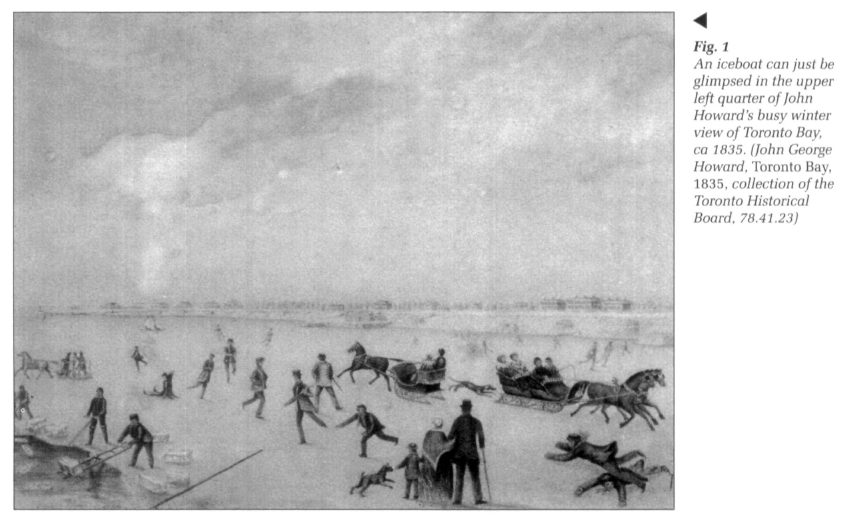 Display large image of Figure 1
Display large image of Figure 12 Since before the time of the earliest European settlement in the Toronto area, the waters of Toronto Bay and Lake Ontario had been of use in the winter. After the arrival of the Europeans in the seventeenth century, the obvious strategic importance of the waterways to the defence and development of the country carried through to the winter months too, for in 1754, French soldiers stationed at the fur trade post of Fort Rouille saw another party of soldiers pass by them into Toronto Bay, in the course of travelling from Quebec to Niagara. What made at least this portion of the journey remarkable was that the men were skating on the ice of the lake, towing sledges behind them.2
3 With the arrival of the Simcoes in 1793 to begin the development of York, which later became Toronto, winter recreation in the area gained an enthusiastic proponent in the person of Elizabeth Simcoe, wife of the Governor General. She mentions in her diary that she had seen young Lt Thomas Talbot skating across the bay, and she herself delighted in driving carioles and riding horses on the ice. Elizabeth Russell, another early resident of York, also remarked about the "delightfull slaying [sic] on the bay."3 Many early depictions of the frozen harbour show a range of winter activities taking place. For instance, John George Howard's watercolour Toronto Bay, 1835 shows people sleighing, skating, promenading and harvesting ice.4
4 Winter recreation activities became more organized in 1839 when officers of the Garrison and some citizens of the town formed the Tandem Club, a group which seems to have had two principal aims: to drive very fast through town and then on to the ice in tandem sleighs, and to afterwards commemorate these drives in verse of rather uneven quality.5 These were not the only winter activities possible on the bay, though. Amidst all these sleighs, skaters and promenaders in Howard's painting can also be seen something which was to be a characteristic and popular part of winter in Toronto for over 100 years. I refer, of course, to the ice-boat (Fig. 1).
5 It is generally agreed that iceboating had its origins in Holland in the early seventeenth century. The first iceboats were the result of a logical evolution: to the bottoms of small sailing craft, the Dutch attached iron blades held by a triangular wooden framework, oriented with its apex towards the stern of the boat.6 The regular cockpit of the boat held the occupants off the ice, and the existing sails and rig sufficed to propel it. Such a development was natural for the Dutch, who were already known as a nation of skaters, and had available to them thousands of miles of protected waterways which froze every winter.
6 Although the exact route of transmission will never be clear, it would seem that knowledge of iceboating arrived in North America with immigrants from Europe. Brief references are first made to iceboats in the general region of the Hudson River valley, later to become one of the major centres of American iceboating, in the early 1830s, which mention "rough frames mounted on skates." By the 1840s, a resident of Poughkeepsie, New York, had constructed an iceboat with specially-made runners instead of reused skates.7
7 As early as 1824. however, iceboats had made their appearance in Toronto. In that year, a young man named Isaac Columbus, who had served the British Army as an armourer during the War of 1812, set up shop at the corner of Duke and Sherbourne streets, and advertised that he could make and repair, among other useful things, "the irons of an iceboat," referring to die boat's blades or skates, often made at that early date from wrought iron.8
8 The citizens of Toronto presumably availed themselves of Columbus' services to work on their iceboats, and the sport flourished. By 1840, the young Toronto lawyer Larrat Smith could write in his diary of a winter's day:
Chroniclers of the life of the harbour, such as the watercolourist and engineer William Armstrong, himself a keen iceboater, yachtsman and early member of the Royal Canadian Yacht Club, often depicted iceboats in their works (Fig. 2). From the 1850s to the 1880s, the popularity of iceboating in both Canada and the United States continued to grow as the strengthening of the nineteenth century economy provided more time and money for leisure activities10.
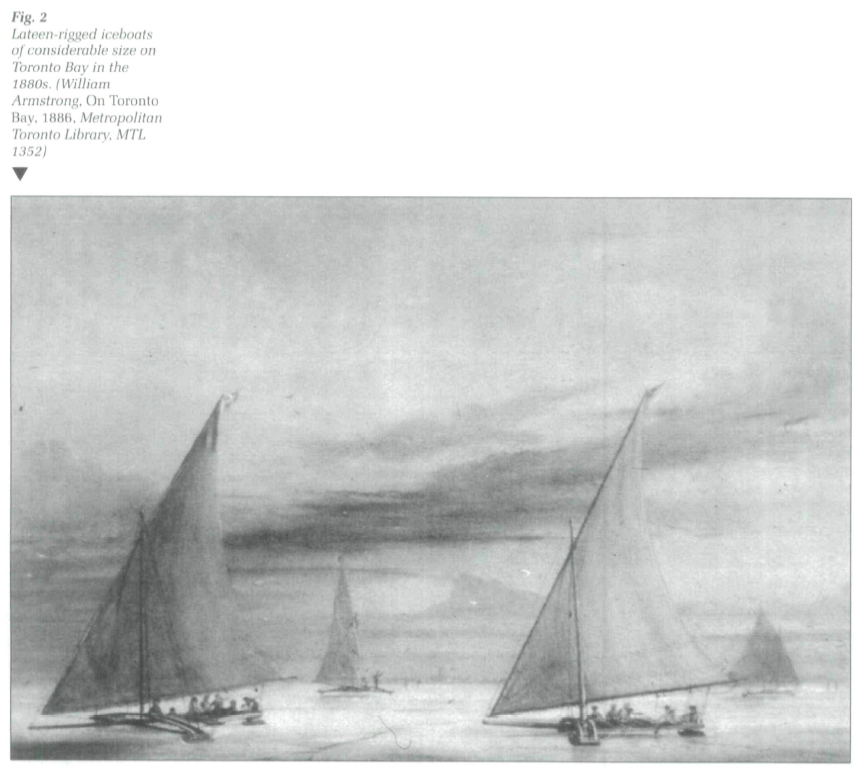 Display large image of Figure 2
Display large image of Figure 29 British yachting writer Dixon Kemp observed in 1895 that "On the Hudson and smaller lakes of Canada the sport is as much a winter amusement as cat-boat sailing is at the watering places during the summer months."11 Perhaps because many of the winter sailors of iceboats were also yachtsmen who were involved in racing during the summer months, fierce competition flourished as the sport developed.
10 The Toronto Rowing Club and the Toronto Iceboat Association both frequently staged races over triangular courses on the harbour from the late 1870s onwards. Reflecting the long association of iceboating with the residents of the Toronto Island, many of the competitors in these races were Island residents and in February, 1871, Mrs. Parkinson, owner of Parkinson's Hotel on the Island, donated a silver iceboating cup for which sailors competed.12
11 These races and activities were avidly reported upon in the press of the day. The Toronto newspaper The Leader described one such race in 1872:
Because of their simple construction many of these iceboats were built, often by the people who sailed them, in backyards and garages throughout the city and the Island. Racing sailors who were keen to gain any possible advantage, however, could turn to professional boatbuilders for a more sophisticated craft. Two of die most prominent of these were Walter Dean and the Durnan family. The Durnan family had been residents of the Toronto Island since the turn of the century, when James Durnan was appointed keeper of the Gibralter Point lighthouse. In 1870, his descendent Edward Durnan established a boathouse on the Island, where he conducted a livery and construction business, building iceboats and rowing craft.14 He maintained a fleet of iceboats which earned their keep transporting passengers to and from the Island during the winter, and included boats such as Jack Frost, Beaver, Stormy Day and Islander.15
12 Walter Dean is perhaps Toronto's best-known small craft builder. His reputation rests primarily on the Sunnyside Cruiser, a recreational canoe which he made and rented in great numbers from his boathouse in the Sunnyside amusement park in the early twentieth century, but he was also known to be a builder of iceboats.16
13 For residents of the Toronto Island, iceboats were much more than racing craft to be used solely for recreation, though. The freezing of Toronto Harbour each winter meant that regular ferry service was suspended while the ice was thick, and the resourceful Islanders travelled to and from the mainland across the ice by sleigh, automobile, carriage, skates and iceboat.
14 Some of the boats transported workers to die Island, such as the employees of the water filtration plant, who would arrive to find them waiting at the water's edge in the morning. Most of the fleet, however, served as an alternate ferry service, offering rides of dizzying speed and chilling cold across the bay. On a typical winter's day, as many as 50 boats would be "parked," with their stern runners turned at right angles to the boat, at the foot of York Street waiting for passengers. Left this way, their sails could remain up, for if they were caught by the wind, they would simply sail in circles. Sailing with a crew of three, some of whom would function as ballast on the end of the runner plank if the wind was brisk, the boats could carry 12 or 13 passengers who lay on mattresses in the cockpit to keep out of the wind.17
15 In the early twentieth century, the harbour was patrolled during the winter by iceboats of the City Life Saving Service and later the Life-saving and Police Patrol. These typically had a crew of three and were equipped with lifebuoys. Although useful in good weather, since they could quickly respond to emergencies, officials of the service also admitted of the iceboat that "under certain conditions [it] is of little or no assistance in actual lifesaving work." To warn iceboaters and skaters away from dangerous spots, old christmas trees were collected early in the new year and were set in holes chopped in the ice to show hazardous conditions18 (Fig. 3).
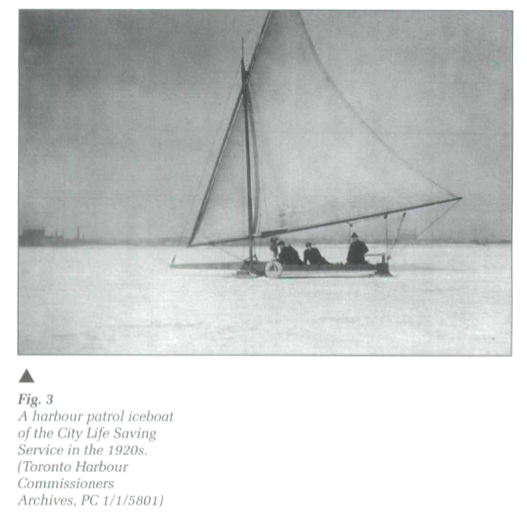 Display large image of Figure 3
Display large image of Figure 316 Ironically, it was the Toronto Harbour Commissioners, the same organization that oversaw the Life Saving and Police Patrol, which was partly to blame for the decline of iceboating in the harbour. Early in the twentieth century, this federal body began an ambitious programme of modernization and improvement in the harbour, filling in Ashbridge's Bay and creating new land along the northern and southern shores. A change was also made to the western entrance to the harbour, known as the Western Gap. Long unpopular with shipmasters, this narrow entrance was difficult to keep dredged to an adequate depth.
17 The old gap was filled in, and a new and more regular channel was dredged to the south of it. At the same time, more large ships were being used for winter grain storage in the harbour, and they had occasionally to be moved from berth to berth. These two factors, and the Harbour Commissioners' lake filling, combined to ensure that not only did the ice not form as regularly as before, due to changing current and flow patterns, but that when it did, it might be broken up by the movement of a large ship.
18 Though gradual, these changes in the harbour did not go unnoticed by at least one iceboating enthusiast. In 1910, Toronto artist William Buckland applied to sue the federal government, responsible for ports and harbours, because they had "deliberately destroyed Toronto's finest winter pastime — iceboating on our bay," by relocating the Western Gap. Though never allowed to press his suit, Mr. Buckland continued to harass any politician who was close at hand about the quality and quantity of ice in the bay during the winter.19
19 As late as 1927, the Star Weekly ran a photograph of six large iceboats awaiting passengers, and mentioned that "ice boating [was] popular on Toronto Bay this winter."20 Iceboating sustained a further blow, however, when icebreaking tugs, such as the Ned Hanlan (now in the collection of the Marine Museum of Upper Canada) and the fire tug Rouille began providing a winter ferry service (the Hanlan in 1932, the Rouille in 1929). Their routes, from the city across to Ward's Island, Centre Island and Hanlan's Point, cut right across the old triangular race courses which had formerly been laid out between the island and the mainland. In the words of Toronto marine historian G. H. J. Snider, these and other changes "rang down the curtain on Toronto iceboating."21
20 This was not completely the end of the sport which had begun over one hundred years before. In February 1941, winter conditions were sufficiently severe that ice formed on the bay to a depth of 38 centimetres. Members of iceboating clubs, which had moved to Lake Simcoe and other locations as activity diminished in Toronto, were quick to return and arrange races. The boats they sailed bore little resemblance to the old lateen-rigged stern-steerers, though. Iceboating in southern Ontario had finally caught up with technological development elsewhere, and these iceboating revivalists sailed marconi-rigged, bow-steering iceboats, organized into classes by size and sail area. This activity had a philanthropic purpose as well, for the fares collected from passengers who were ferried to the Island in as little as 50 seconds were in large part donated to the aid of the Telegram British War Victims' Fund.22
21 Although ambitious plans were made for a series of international ice-yacht races, and "the men responsible for the return of ice boating on Toronto Bay are confident that a great interest in the sport will be developed before the season is over," the winter of 1941 marked the virtual end of large-scale, organized iceboating in the city.23 When the Marine Museum's iceboat Silver Heels was last sailing in the mid 1960s, iceboating was only possible on the lagoons inside the Toronto Island, and immediately along its northern shore. Silver Heels generally sailed alone, an evocative reminder of the sport's former popularity in Toronto.
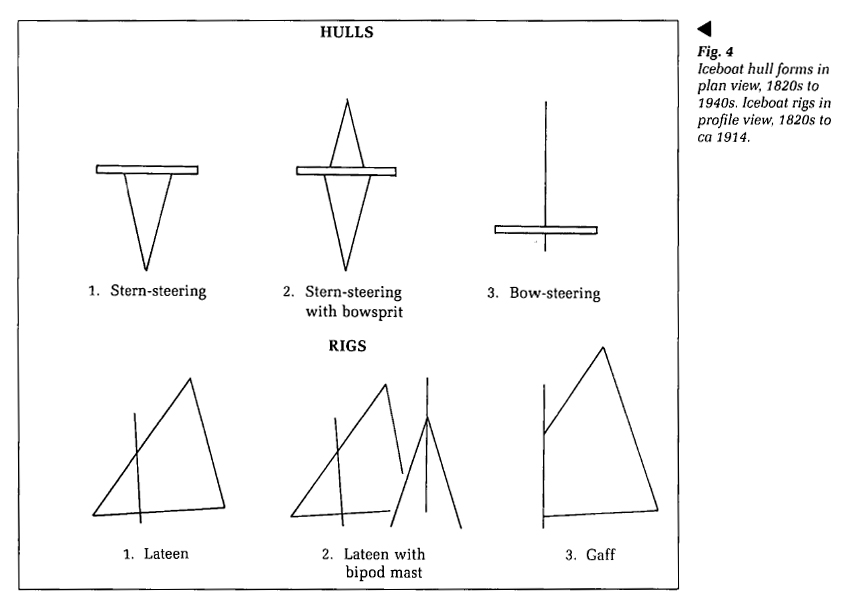 Display large image of Figure 4
Display large image of Figure 422 The iceboats which sailed in Toronto Bay from the 1820s to the 1940s were of three main hull types (Fig. 4). Though it is tempting to see these types as evolutionary stages, the visual evidence would suggest otherwise. Certainly types 1 and 2 existed side by side for some time. The considerable developmental pressure often exerted on watercraft models by racing does not seem to have been a decisive factor in iceboat development for the Toronto area. The Toronto type remained an anachronism in and of itself in the larger context of iceboat development well into the twentieth century, local technological conservatism ensuring that the same design was built over and over.
23 The earliest depictions of iceboating in Toronto show a craft that is remarkably similar to seventeenth-century Dutch examples, the only difference being that die triangular framework does not have a boat hull on top of it. These earliest boats, though structurally unsophisticated by later standards, show two features common to almost all iceboats since (1) they have a roughly cruciform shape in plan, and (2) the arm of the cross is formed by the runner plank, the widest part of the boat. The boat's three runners are placed one at each end of the runner plank and one at the stern. For these type 1 boats, that was the entire structure of the hull, Uiere being no "bowsprit."24
24 The cockpit aft of the runner plank was characteristically formed by two wide, thick planks on edge, which met at the stern with reinforcing pieces above and below, which also provided support for the rudder post which projected through them. Planking, often tongue and groove, was laid athwartships on the bottom to form the cockpit floor, and a wide plank crossed the forward end of the cockpit, often leaning forward at an angle. The runner plank was formed from a thick plank with two smaller boards flexed across it, forming a truss which was airfoil-shaped in its longitudinal section. Between these and the runner plank, the sides were placed, being through-bolted to the bottom of the runner plank. These two smaller planks bent across the top of the runner plank also formed the mast partners through which the mast entered. Boats of this most basic type appear in paintings of the harbour as late as the 1850s, suggesting that they were replaced only gradually by boats of the second type.
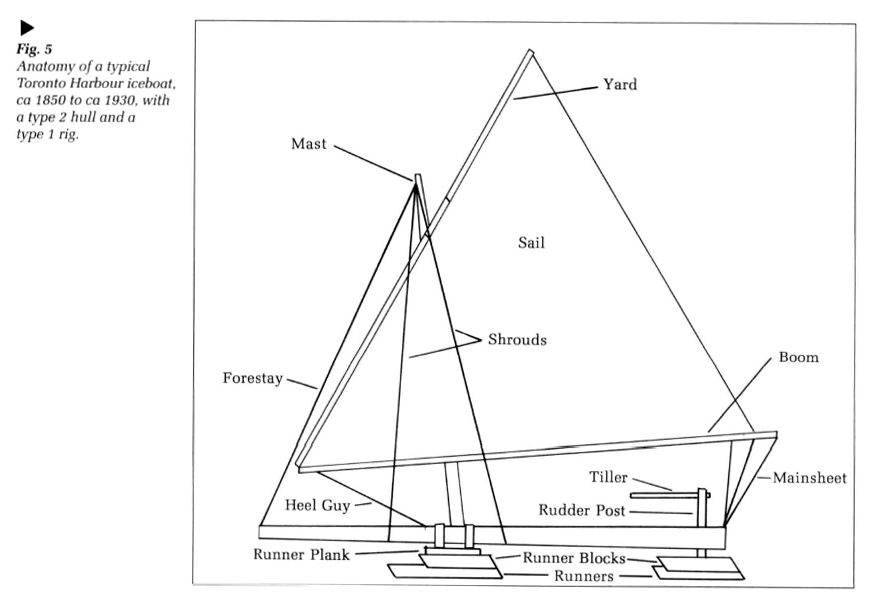 Display large image of Figure 5
Display large image of Figure 525 The principal difference between these two types lay in the addition of a bowsprit. Like the cockpit, this was formed of two planks fastened together at the forward end. The after ends of these planks were also socketed and bolted into the runner plank, between the ends of the cockpit planks. The advantage of the bowsprit was that it provided an anchorage point for a forestay, and so the boat could have a securely-slaved mast with a conventional arrangement of two shrouds and a forestay. In many of the Toronto boats, there were two shrouds each side, one to the cockpit side and one to the end of the runner plank, reflecting the enormous loads imposed on the rig by the boat's great speed.
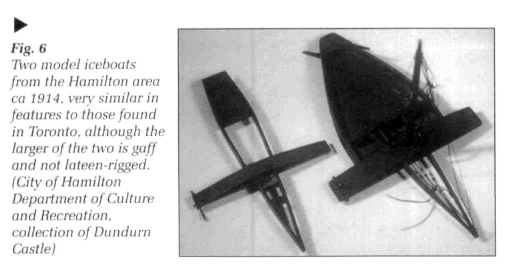 Display large image of Figure 6
Display large image of Figure 626 It was this boat, with the bowsprit, which was to become the typical Toronto Harbour iceboat (Fig. 5). These same features are shown in two very interesting model iceboats constructed ca 1914 from memories of iceboats seen on Hamilton Harbour before the turn of the century (Fig. 6). In the larger of the two, the shape and arrangement of the cockpit, bowsprit and runner plank can clearly be seen, testifying to both the accuracy of the modeler's recollection and the ubiquity of the type.
27 Based on a considerable body of visual evidence, it can be said that both of these types of iceboat had emerged in Toronto by the middle of the nineteenth century. What makes the situation there unique is that nothing else emerged until the 1940s, during the brief revival, when up-to-date iceboats finally appeared on the bay. These type 3 boats had been in use elsewhere since the 1890s. Their principal difference from the Toronto types lay in the position of the runner plank, which had been moved to the stern of the boat. This removed the last vestige of the iceboat's origin in small sailing craft, for no longer were they steered from the stern with a tiller connected to a rudder/runner. These newer boats were steered by their single runner at the bow, often by cables led to an automotive-style wheel.
28 While Toronto iceboaters continued to build and refine the same basic model through the end of the nineteenth century and into the twentieth, iceboaters elsewhere entered a period of furious technical development, spurred, as is often the case, by racing. In Toronto, by comparison, competitive energies seem to have been focussed more on helmsmanship than on modifications for speed.
29 The acknowledged leaders in this developmental process were the iceboaters of the Hudson River clubs in New York state. The "Hudson River Style" of boat came to mean a boat with a single backbone instead of the old triangular frame.25 This was often a sophisticated hollow structure, braced underneath with a wire truss for rigidity. The rigs on these boats also progressed rapidly, mirroring developments in yachting generally, so that by the 1930s, they were using "marconi" or bermudan rigs, with high-aspect-ratio battened sails.
30 By comparison, no characteristic is more definitive of the Toronto iceboat than its lateen sail, the preferred rig from the earliest days of the sport on Toronto Bay until the 1930s. That Toronto boats were known for this rig outside the city is shown by Dixon Kemp, who remarked in 1895 that "As a rule, nothing but two sails are carried [on iceboats], the ice yachts of Toronto having but one lateen sail."26 The rig is thought to derive its name from the trench voile latine, reflecting its Mediterranean origins. In its iceboat form, the sail is triangular in shape, with a spar along the upper edge, the "yard," and along the lower, the "boom." It is hoisted by a halyard tied slightly more than two-thirds of the way up the yard. On iceboats, the sail is held in position, once hoisted, by a line called the "heel guy," which runs from the "tack," or forward corner of the sail, to an anchorage point forward of the mast.
31 Since the natural tendency of a triangular shape hoisted by one side would be to capsize and find equilibrium with the point downward, this line serves to right the sail, and keep the boom roughly parallel to the boat by pulling back on the tack. At the mast, the boom is held in by a parrel, a loop of line around both mast and boom. No parrel was used aloft, where the yard was always hoisted as high as it could go, and the halyard therefore kept it close to the mast.
32 The lateen has several advantages as a rig for iceboats. It is very "weatherly," allowing boats to sail close to the wind, because the yard forms a long, clean leading edge for the sail. The rig is quite powerful, with a low centre of effort which reduces the heeling force on the boat. The mast required is not long, due to the yard extending above it, and is therefore simple to build and stay. The gear and spars required for the sail are very simple, as can readily be seen in the Toronto boats. Unlike the high marconi masts used later, the rig requires no complex staying.27 The spars are rounded, solid baulks of wood, and the shrouds are held in place with rope lanyards rove to ringbolts on the hull.
33 On most photographs and paintings of Toronto iceboats, the reef points, used to reduce the area of the sail in strong winds, are shown running parallel to the boom. The reef points on a lateen rig, however, proceed outward from the tack, radiating to the "leach," or after edge of the sail, and ones set up as shown for the Toronto boats could not be used. This apparent anomaly of the reef points seen on such boats as Comet in Fig. 9 can be explained by the fact that the iceboaters have reused and recut mainsails from large conventional yachts, which did have reef points parallel to the boom, for their winter sport. This apparent reuse of materials is in keeping with the strong and simple construction of the Toronto boats.
34 What is particularly interesting from a developmental point of view is that while the lateen predominated from the earliest days in Toronto, it did not come into use on the Hudson River until the 1880s. Early American iceboats had used rigs similar to those on the "sandbaggers," high-performance racing craft of the time with long booms and bowsprits. Because of problems tuning and controlling these rigs, though, Hudson river sailors turned to the lateen as a development from these early sloop rigs. The lateen gained favour because it could be easily tuned, raking the mast to move the sail's centre of effort, which changed the balance of the boat and the pressure exerted on the helm. To facilitate this, they turned to a two-legged, bipod mast.28 Only one example of this type of mast has been seen on a Toronto iceboat (Fig. 7). Once again, Toronto sailors would seem not to have felt any pressure to improve upon even their characteristic form, since almost all of the Toronto boats had conventional, single-mast lateen rigs.
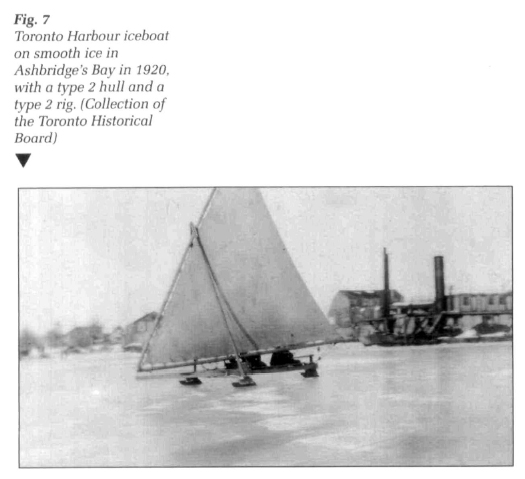 Display large image of Figure 7
Display large image of Figure 7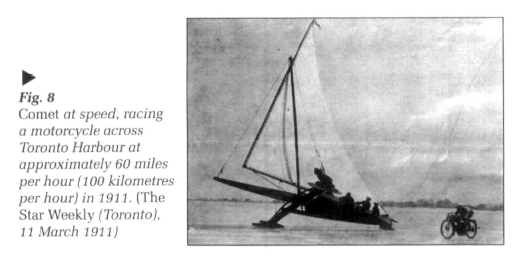 Display large image of Figure 8
Display large image of Figure 835 A great deal has been written about the speed of iceboats, and a great deal of it is likely folklore. What is certain is that, under the right conditions, iceboats are capable of great speeds, and that by the early years of the twentieth century, iceboaters had travelled faster than any other humans at that time. Certain technical problems arise with great speed, however, and as Raymond Ruge suggests, a central issue in iceboat development has not been either speed or weatherliness, as has been the case with softwater craft, but rather control.29
36 The speed at which iceboats could travel was affected by aerodynamic considerations not applicable to slower, more conventional boats, and this was clearly understood by the end of the nineteenth century. In his extremely influential Manual of Yacht and Boat Sailing, a state-of-the-art treatise when it appeared in its eighth edition in 1895, Dixon Kemp devoted several pages to explaining, with vector diagrams, how iceboats could sail faster than the wind. The answer to the question of how they could is, in essence, that they make their own wind as they go. This phenomenon is known as "apparent wind," and the faster the boat goes, the more the apparent wind is drawn towards the bow. This is why iceboats (and modern multi-hulls) almost always sail close-hauled (with their sails hauled towards the centreline of the boat), regardless of the direction of the true wind.
37 The lure of such speed is obvious, and Kemp himself remarked that "Fascinating pastimes like yacht and boat sailing ought to sink into insignificance when compared with the fascinations of ice yachting, if speed alone be the cause of excitement." A favourite sport on the Hudson was to race the express trains which travelled along its banks, suggesting that ice-boats of that era routinely achieved 60 to 70 miles per hour (100 to 117 kilometres per hour).30 A lateen-rigged iceboat is reputed, in 1907, to have achieved the astounding speed of 144 miles per hour (240 kilometres per hour).31 As unsophisticated as they were, the Toronto Harbour boats were themselves able to achieve high speeds. This was graphically illustrated in 1911 when the large iceboat Comet. owned and sailed by the Wells brothers, raced a motorcycle across the ice of Toronto Bay. The race, which reached speeds of 60 miles per hour (100 kilometres), was a dead heat (Figs. 8, 9).
38 It is not known when Silver Heels, the ice-boat acquired by the Marine Museum of Upper Canada in 1987, was constructed, but it is immediately apparent that she displays all of the salient features typical of Toronto iceboats. Setting a lateen sail on a single mast, her hull is constructed from two triangles formed by planks set on edge, whose bases meet at the runner plank. The runner plank is trussed by two smaller planks across the top of the hull, and the mast is stepped directly over it. There are two shrouds on each side, and a single forestay, all set up with rope lanyards (Fig. 10). The Marine Museum has interviewed a number of people who owned or sailed on Silver Heels, and from their comments and the evidence of her form, it seems likely that she was built during the first quarter of the twentieth century.
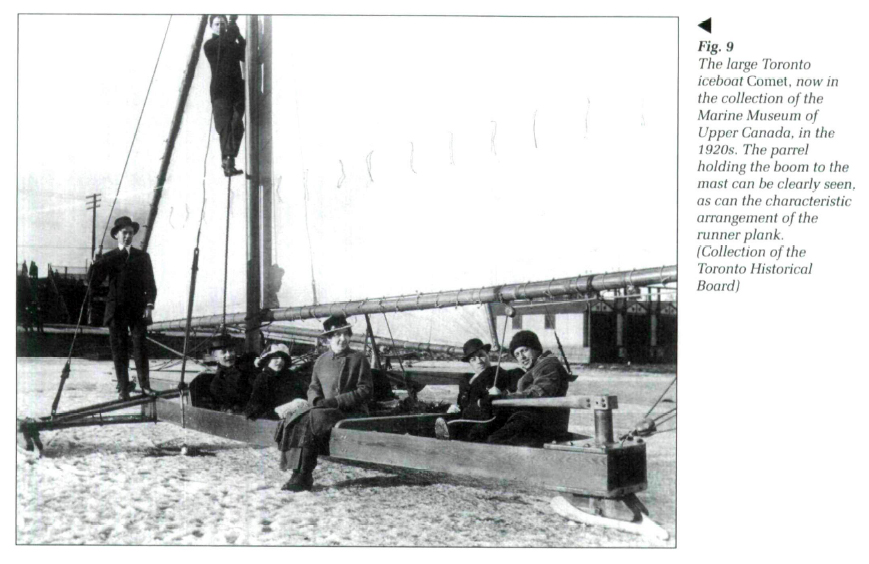 Display large image of Figure 9
Display large image of Figure 939 Through letters and conversations, these people have offered a fascinating glimpse into a vanished era of recreation in the city.32 Many people who have sailed on Silver Heels echo Ian Stewart's boyhood memories, quoted at the beginning of the article, about iceboating being a thrilling but extremely cold sport.
40 Silver Heels and other iceboats were stored, disassembled, on the Toronto Island and in the city during the summer. When the harbour froze over, the three pieces (cockpit, bowsprit and runner plank) and the rig were carried to one of the Island lagoons and assembled. Doug Wells remembers his uncles loading the disassembled pieces of Comet into a wagon to take through the city to the waterfront.
41 Once rigged, the boats were left on the ice all winter, with the runners propped up on wooden blocks so that they would not freeze in with the thawing and freezing of the ice. The sail was lowered and rolled up, and the cockpit covered with canvas to keep out the snow. The tiller was unbolted and taken home, so as to prevent anyone else from using the boat. However, this did not prevent someone from bringing their own tiller, and Ian Stewart recalls several occasions in 1941 when Silver Heels was found abandoned in far corners of the harbour, once with her boom broken.
42 If the boat was to be left for only a short time, the tiller was swung hard over to one side. Storage on the ice in this way had its hazards, however, and Doug Wells remembers that the entire iceboat fleet of the Queen City Yacht Club went to the bottom of the bay one winter when the ice suddenly went out of the harbour.
43 Sailors of Silver Heels mention the boat's rough motion over the ice, indicating a relatively stiff runner plank, which would contribute to the boat's speed. The boat's relatively small size and stem-steering made her very manoeuvrable, with a tight turning circle. Her steel blades were sharpened to a V on one side, for hard ice, and a rounder shape on the other, for soft ice. The action of the runners on the ice produced showers of ice chips, particularly when turning, and Ted Scovell recalls wearing goggles when sailing her.
44 Clonie Jones frequently went iceboating with her father and brother in the 1920s on Silver Heels and says: "I wore woolen stockings and a buffalo robe. We often got dumped. We rolled out several times. You had to lie down [in the cockpit] because of the boom. You would run alongside the ice beside it to give it a push, then you would jump inside. We wore goggles and a World War I helmet, you know the kind the war aces wore."
45 Silver Heels was nearly destroyed when most of the land on the Toronto Island was expropriated for park use in the 1950s. Houses, boats, iceboats and anything else too large to move were bulldozed into piles and set alight after the residents had left. Preserved, she sailed sporadically in the 1960s, the last active survivor of a once thriving and vigorous winter sport on Toronto Harbour which was curtailed by a changing environment. So far as the city is concerned now, the iceboats have vanished as it they never were.
46 The history of these Toronto iceboats is proof that while the broad outlines of North America's small craft heritage are clear, much still remains to be done. This heritage consists, in large part, of specific local traditions bound together by national trends, styles and habits. We do not do it justice to note, simply, that iceboating used to take place, without inquiring much more carefully into when, where and how that occurred.
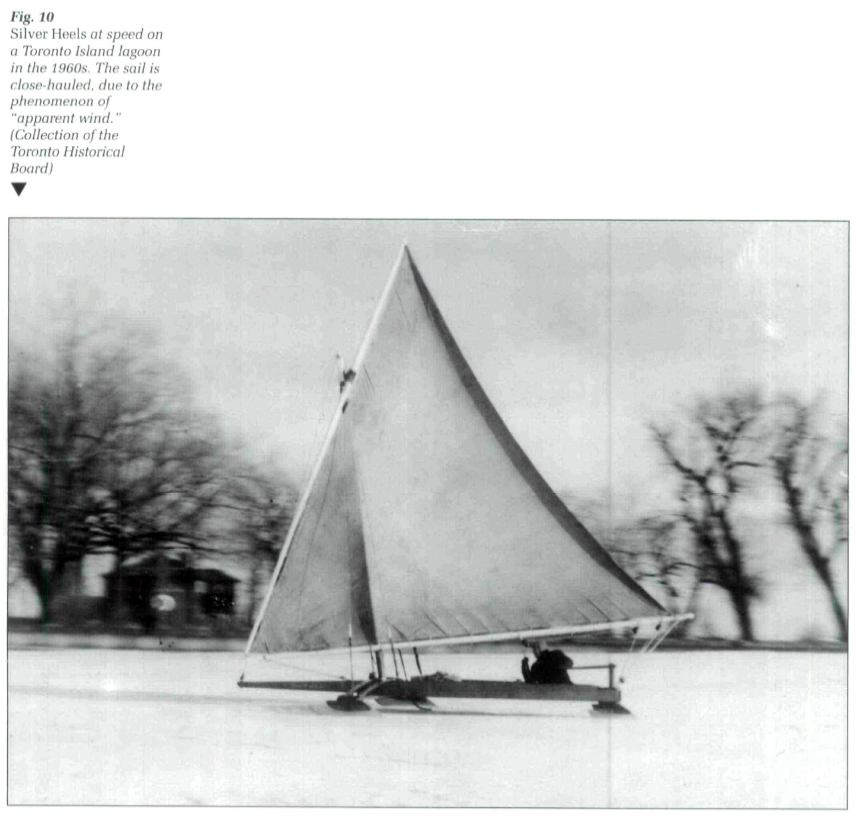 Display large image of Figure 10
Display large image of Figure 1047 In exploring regional variations in small craft, we can begin to lay bare the complex array of forces which govern the shape and use of a particular artifact. In the case of the Toronto iceboats, national conditions caused the sport to flourish, but the city's location and innate design conservatism combined to arrest their development, producing a particular design which persisted well past the point of technical obsolescence.
48 Looked at in this way, many small craft designs which are assumed to be near perfection can be seen as being in reality the products of a more prosaic set of influences, ranging from local conditions, to taste, to prejudice. This is not to suggest, however, that Toronto's ice-boat era was not a singular and fascinating episode in the city's history.